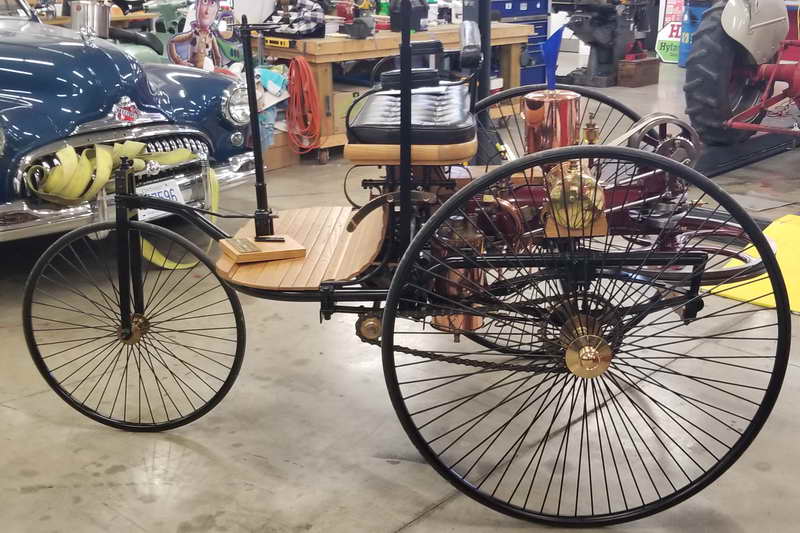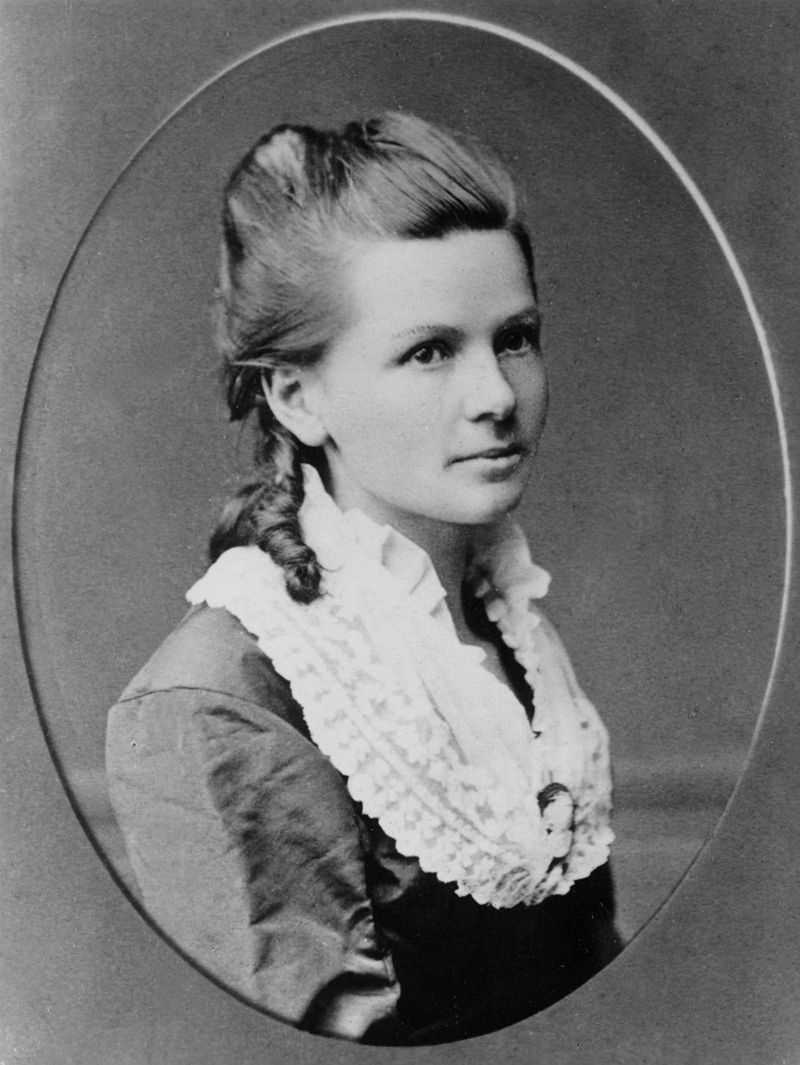Riding the 1886 Benz Motorwagen That Built an Industry
“Why don’t we start it up?” asks Wes. We’re sitting at a picnic table on the outer edge of his sizable collection, inside of an eight-bay pole barn structure. This is where he houses his mix of antique cars, fire trucks, and various other mechanical marvels and oddities that have struck his fancy over the years.
He says, “People collect cars for all different reasons. I like the cars, and I enjoy talking to people about them. It’s not really a status thing. This is not an open museum, it’s just my own sandbox. But yeah, if you walk through the shop I’ve got all the oddball shit.”
Everywhere I look there are pieces of history, both large and small, from agriculture, aviation, and the automotive industry. This place is clearly dedicated to mechanical things and curated based on fuel, oil, worked metal, and ingenuity. There is a large farm tractor, cut in half (yes, top to bottom, front to back, the engine to tires). There is a jet engine (yes, you read that right) of the type that was used in the CF-105 Avro Arrow. There is even a barstool, mounted on a V-8 engine and wheels (yes, you can drive it). It’s an amazing place, made all the more interesting by the unexpected things and people, you find here.
The collection is wide-ranging, but there is reason behind it. Speaking of the vehicles, in particular, Wes says, “If you stare at them long enough you can figure out how they work. Once you understand one of these old cars, you can understand a new car much easier. I just love the history of them. They don’t go anywhere in a hurry, you’re not going to go to Toronto in one, but they’re just so much more interesting.” He prefers old cars, too, ones that were very near the start of the automotive industry. “A lot of people like cars and muscle cars from the 1960s, and I admire that. But they’re not as primitive. [In older cars,] there’s metallurgy, there is the chemistry of fuels. At this time, all bets were off. They didn’t know what the hell they were doing.
“They [car builders] were the pioneers. They didn’t have paved roads. They carried the gasoline home. If they wanted to use the car on the weekends, they would go buy a couple gallons from wherever they could get it and then bring it home. To me, it’s just real interesting. I just like it.”
“On these old cars, you can see maintenance procedures that have nothing to do with anything we’d recognize today. The fuels were so poor they would leave deposits in the engine, making them hard to start and everything else. Right up to the ’30s in engines it was real easy to get to the valves because they were always screwed up! The fuel wasn’t good enough. Everything was a fuel then. If they could get it to ignite, that was good.”
Bringing the Motorwagen to Life
This brings us to the reason I have been invited over today, the opportunity to drive a replica 1886 Benz Patent Motorwagen. As we approach the car, there is a palpable feeling of stepping back into a time before horseless carriages (or automobiles, as we know them) were a common sight on the roads. This three-wheeled Motorwagen is more than just automotive history. It also played a part in the struggle for equality between women and men.
Depending on your financial position, there were, essentially, only three possible modes of ground transportation in the late 1800s. You had your feet, a horse and carriage, or maybe the steam train if you had money to spend on a ticket. Bicycles were becoming all the rage at this time but were only a slight improvement over walking. Inventors had been striving to build a mode of conveyance like a horse carriage but without the horses. Some had come close, with carriages powered by steam and fueled by coal wood. A few had even experimented with electricity. None had proven practical yet, and none had gone into production.
The trick was to figure out how to build a small engine that would run on a fuel that wasn’t bulky like coal or wood, and that was easy to carry with you. Carl Benz, born in Germany in 1844 was destined to be that inventor. He pursued a degree in mechanical engineering and graduated, at age 19, from the University of Karlsruhe. He worked at a succession of firms where he honed his skills and ideas. During this time he began to court Bertha Ringer. Bertha came from a wealthy family, and her belief in his ability led her to invest in his companies. Upon their marriage, her dowry financed even more of his ideas including the Benz Patent Motorwagen.
Many people had been working to perfect the horseless carriage. With the additional financial resources his wife brought, Carl was able to overcome one of the largest design challenges by building an engine that was small and light enough to be installed on a small carriage. He was also able to solve the problem of fuel storage by using Ligroin, which was a petroleum product used in dry cleaning at the time. He understood that the amount of energy available per litre in what was essentially gasoline would allow him to reduce the overall size and weight of the vehicle while still carrying enough fuel to allow the car to go a reasonable distance. Thus, the 1886 Benz Patent Motorwagen was born.
This vehicle was refined over the next few years and the third version became what is, essentially, the first production vehicle. Approximately 25 of them were built and sold by 1893. Not very many of these cars exist today, and the ones that do are permanent fixtures behind museum walls. As with many historic things, however, there was a desire, a century later, to recreate the thrill of the first vehicles to hit the road. More importantly, there was a market for them. The replica was on the loose!
On the first impression, the car itself looks rickety, primitive, and strangely elegant all at once. A large, leather, two-seater bench-seat sat on springs above a nicely varnished wood chassis. Its three wheels resemble those from an old High-Wheeler bicycle, yet also have elements that look like they belong on a horse-drawn wagon. The engine and components, including the large, heavy flywheel, are completely exposed to the elements. This open concept provides a fascinating look at how everything works together, while also promising a threat to your arms, hands, and fingers if you grow careless.
Wes says, “What I like about this car, because I am kind of a gear-head, is that when you look at it long enough you can see all of the things that we recognize today in an automobile engine with internal combustion. There is something that resembles a carburetor, there is something that resembles a piston, there is something that resembles a cooling system to keep the motor from overheating. Those elements are still in cars today, much more refined.
“When this car was built they had internal combustion engines. They were used on farms and in factories. But they were great big, heavy, honkin’ things that weighed a TON, with big flywheels. It was just like putting a nuclear plant in your farm. But [Carl Benz] designed this motor and it only weighs a little over two hundred pounds, which was another breakthrough. That made it practical for this application.
“The wheels apparently are of his design. I guess they didn’t work out well because in succeeding models he went back to wooden wheels. This was just right on the cusp of when bicycles went crazy in urban places. It’s of that thinking.
“I get a laugh out of the steering gear. I mean, at this time they were steering boats and different things. This one is a kind of a tiller system, but it has an arrow on it which points in the direction you kind of anticipate the car to go, because people wouldn’t know automatically – it wouldn’t occur to them. People were steering horses, or tillers at the back of sailboats.”
According to Wes, Benz had gotten things mostly right, at least conceptually, in this design. “The concepts that he used with this car remain valid today. After he came along, we had cars in production, but the only ones that were truly successful –the Curved Dash Oldsmobile, the Model-T Ford– understood that it had to be light and durable to be practical. There were automobiles that came along after this that were extravagant and really posh, but they weighed a fricken ton! And you had to have a full-time mechanic to keep them running.
“Benz understood that light and durable were key to making this thing work. That follows through to one of my favorite quotes from Colin Chapman, who was the engineer for Lotus Racing. In the 1950s or ’60s, he proclaimed, ‘Simplify, then add lightness.’ Horsepower,” Wes continues, “ will make you faster in the straightaways, but lightness will make you faster everywhere. Even Benz understood that unwritten rule about getting something to move on its own. “
That an original of this machine still exists is due, in significant part, to Bertha Benz’s willingness to challenge cultural norms and her belief that she was equal to any man. In addition to funding his projects, Bertha assisted her husband by pointing out flaws and alternatives to components of his inventions, which ultimately made them better. And, finally, her determination to see the final product marketed ensured that the Benz Patent Motorwagen would be more than a historical footnote.
Bertha Benz drives the Motorwagen into Legend
Carl and Bertha lived in a time when, as a single woman, Bertha was allowed to make her own financial decisions. Once she was married to Carl and became Bertha Benz, this independence was taken away from her, by law and custom, as her fortune became his. No law or custom, however, could take away her spirit and will which, in the end, worked out well for Carl, even if he would end up being possibly the first victim of car theft along the way!
As the story goes, Carl had one of the Motorwagens at their house. He could not see how to move forward with production, as there was no market for the vehicle as of yet. The Motorwagen itself was a bit impractical as it could not outperform a well-trained horse and wagon team. This made it hard for Carl to see his next move. Bertha, however, was undaunted. She understood that a demonstration of the machine’s ability was required: People had to hear about it, see it in use, and want it for themselves. So, because of her innate understanding of marketing, she became the first car thief.
Bertha had told Carl that she was going to visit her parents in another town, about 105 kilometers (65 miles) away. She would be taking their teenage sons with her and would be gone for a few days. What she did not tell him was that she planned on taking the Motorwagen. As she drove off, her two sons sitting on the bench seat beside her, they had no idea of the history they were making with each meter they drove. Bouncing over rugged roads caused things on the car to break. Bertha had to find sources of fuel along the way and even made some improvements on the fly, such as adding a leather pad to the wooden block that acted as a brake. What people saw was a woman, alone with her kids, riding into town after town on this noisy contraption. She generated a lot of talk and a little scorn from those who did not know her and doubted her capabilities simply because of her gender.
“Don’t get me started on Bertha,” exclaimed Wes. “I’m in love with the woman. She was an engineer, she was independent-thinking. She was everything. She fixed the car on the trip she made. With a hatpin, she cleared out a clogged Ligroin [fuel] line. She pulled her garter off and insulated a wire that was shorting out. All on this trip, by herself. I mean, she knew what she was doing.
“She could see the big picture. He was the typical idiot savant. Mechanically, he was very clever, but she probably had to tie his shoes every morning! But that didn’t stop her. She went out and did this thing. So she holds three-quarters of the interest for me. This was a time that for women, if you weren’t Queen Victoria, you didn’t get credit for anything, anyway.
“It was such a different time. Suffragettes didn’t make any true headway until the First World War. She was so far ahead of her time. You know, put it into context. There were no gas stations because there were no cars. The fuel that they used was a dry cleaning fluid. They had to find a pharmacy to procure some. There wouldn’t have been many women who drove teams of horses, let alone a horseless carriage. She would have been dismissed by so many men in that time. “
Bertha’s 105 KM trip took the better part of the day, over rough roads gouged with ruts from horse-drawn carriages. Her sons were put to work as they came to hills – the Motorwagen was fine on a flat surface, but didn’t have the power to climb anything that was very steep or very long. “Bertha had to be pushed up several hills on her trip. It’s got–not many torques,” he says with a laugh. “It’s not even one horsepower. You see a hill coming and you get her up to a full 8 MPH and hang on for dear life. “
Once she arrived at her parent’s house, Bertha sent a telegram back to her husband informing him that they had made it and that she had done it in his invention. A few days later, they would drive the car back. She would have suggestions for him to improve the contraption, and she had generated interest in the car that was picked up in the newspapers. Bertha had shown that a woman was the equal of a man, she had stolen and returned a car, and she created the automotive sales industry through her marketing prowess. She was a remarkable woman.
Bringing the Motorwagen Back to Life
I am excited and looking forward to getting to experience, at least in a small way, driving one of the first automobiles. Wes gives a quick history of his particular replica which was built around 1997. “This one was built by a fellow in England. Mercedes-Benz fought with him for years because he was able to get his hands on the original paperwork. He had all the original specs on it. Mercedes-Benz was cranky about it and he fought with them the whole time. Then MB came around and realized what a marketing thing this was and they worked with him on the second batch.
“They were originally available to Mercedes-Benz dealers around the world and I think a total of 90 were built. Most of them sit silently in corners. There are a handful in the world that people actually run, and this is one of them.
Wes gives a brief description of what to expect. The two large rear wheels are powered by a chain drive that is itself powered by the engine. He explains, “It has a drive belt that is attached to the flywheel. With a lever, it tightens up and starts to move the car forward. It’s just one lever. It doesn’t snick into any gears or anything. You tighten up the belt by pushing the lever forward. That’s all there is to it. There’s no reverse, although if you pull back on the lever it will tend to stop the car. In those days it wasn’t so much a brake pedal as a “retard forward motion pedal” but they weren’t going very fast, anyway.
“You’re going to find out that getting them started is a bit of an issue, it’s a delicate thing. It takes a few minutes to get it running but that’s part of the charm of it. “
Charm, it could be said, is in the eye of the beholder. In order to start the car, the carburetor has to be filled with gasoline and the engine primed. Oil has to be set, manually, to drip onto exposed gears and rods. The large flywheel has to be spun by hand, like starting an engine by pulling the propeller on an old airplane. You have to have the balance of air and fuel just right in order for the engine to catch and run. Once it is running, you have to adjust that balance to keep it going until it runs steady. Charming, indeed.
Today, starting the Motorwagen would prove to be a challenge, taking nearly a half hour and the efforts of three people. Luckily, Josh, who works for Wes, happened to be there and he took the most turns at spinning the heavy flywheel in an attempt to get the engine to fire. It’s an odd thing, but when you spin the flywheel, and the Motorwagen doesn’t start, it is like a challenge to your very being, one that forces you to keep trying. Josh, thankfully, accepted that challenge. Many times cheers turned to groans as the beast gave a mournful ‘Pffft” and then nothing more. I am assured that this is not normal, that it’s usually a matter of ten minutes or so. It doesn’t matter, we are all grinning, as we know it’s worth the wait.
Finally catching, the whole car shakes in time to the slow wheeze-pop-whoosh sound of the single-cylinder going through the combustion cycle. Wes adjusts the fuel and air mixture and the rpm on the engines picks up a little and the shaking smooths out. He climbs aboard and offers my wife the first ride. Off they trundle at about 8 MPH, which sounds slow, but on this contraption looks a bit fast.
After a few laps around the back of the shed, it’s my turn. Wes jumps off and I climb up to sit on the remarkably comfortable bench. On my left is a lever. Pushing it forward engages the belt drive and makes the car move ahead. At the center position, the belt is disengaged from the drive and the vehicle is effectively in neutral while pulling back puts pressure on the brake to slow it down. Engaging the belt, the engine labors and slows down but the car starts to move. Acceleration is smooth and quickly up to top speed which, again, isn’t really that fast. And yet, the end of our driving area seems to approach quickly. I pull back on the lever into neutral, while the engine revs back up with the load removed. Still moving too quickly, I continue to pull back on the lever to engage the brake, while turning the tiller. The Motorwagen is stable on its three wheels and negotiates the turn easily.
It doesn’t take long to slip into a comfortable rhythm of pushing and pulling the lever to control the speed while steering through tight turns. It’s an instant hit of dopamine, too. The sun is out, and it’s a warm November Day. This is fun and novel. And I think I know exactly how people must have felt that first time they got their opportunity to drive one. For a few minutes, I am back in 1888, and I love it, smiling and laughing with each lap I drive.
Eventually, time is up and we drive back into the garage and shut down. I know I have just experienced something remarkable, the first in a series of assumptions and engineering solutions that would lead to our modern cars. Wes states, “They were a novelty and would be for someone who had extra money and could see some potential in this thing. Practical? No. It was something maybe on weekends you could drive up and down the lane with and impress your friends. But there are people like that. Who were the first people who bought Segways?
“You could argue [automobiles] weren’t practical until 1903-ish when Oldsmobile came up with the Curved-Dash Olds that was light and simple and quick. To me, that’s the second landmark car.”
Discussion of the performance of any vehicle is part and parcel of owning and collecting. On driving distance, Wes says, “You can go one carburetor full. I don’t know how far that is. You fill the carburetor with gas and then you shut off the gas tank. It will run until it stops evaporating from the carburetor. Then you have to recharge the carburetor. It goes 2, 3, maybe five miles, I’m not sure. The concept of saving the oil in the engine was–well–nobody ever thought of that until about 1910. They dripped it in the top and it ran out on the ground. That was it. Use it twice? Are you kidding?” Wes said, laughing. “This one isn’t licensed for the road. It can’t be, so we haven’t done any distance on it.
“We just go around the building and laugh like school children.”
It is that statement which sums up the whole experience. The Benz Patent Motorwagen was a novelty then, just as it is now. The replicas, true to the original, give you the same sensory experience as a person would have had 140 years ago. The car is as uncommon and novel today as it was back then. It does what so many fun and interesting inventions do: it brings smiles and laughter, joy, and happiness, to those who get to experience it.
Speaking of the company who decided to build these faithful reproductions, Wes says, “I’m glad they did it. I’m only aware of one original example that exists. There might be more than one, but I can only find one. Mercedes has it in glass in their museum. And these [reproductions] aren’t necessarily collector’s items because they may start building them again next week for all I know. What it does do is it gives people access to it. And you’re more likely to get people interested in it who don’t know anything about it when you’ve got one to start. So, I like that.”
He’s right. Museums are important to save our heritage. To see something in a museum behind glass or surrounded by “do not touch” signs can be satisfying. However, the opportunity to touch and witness a historical object being operated is a different experience altogether. To actually ride in or drive one? Well, that’s a cool story. In this case, thanks to Carl’s inventiveness, Martha’s will, and Wes’s interests and invitation, it’s actually about three cool stories rolled into one.
Photos and Video Courtesy of Amy and Tom Slager
Carl and Bertha Benz Portraits are in the Public Domain












0 Comments